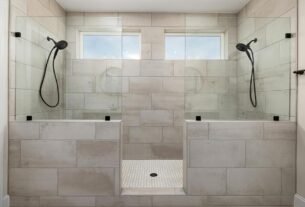Creating a minimalist bedroom can significantly enhance your sleep quality. A minimalist bedroom emphasizes simplicity, functionality, and decluttering. This approach helps reduce stress and fosters a peaceful sleeping environment. In this blog, we will guide you through designing a minimalist bedroom that promotes better sleep.
What is Minimalism?
Minimalism is a lifestyle that emphasizes simplicity and the removal of excess. In interior design, it means creating spaces with fewer items but more purpose. The goal is to have a clean, organised, and functional space that helps you feel relaxed and comfortable.
Minimalism is not just about reducing possessions; it’s about creating an environment that supports mental and physical well-being. By focusing on the essentials and removing distractions, you can create a space that enhances relaxation and promotes better sleep.
Why Choose a Minimalist Bedroom?
A minimalist bedroom offers numerous benefits, especially for sleep. Here’s why this approach might be right for you:
- Reduces Stress: A clutter-free environment can help lower stress levels. When your room is tidy and organized, you feel more at ease. Clutter can cause mental and physical stress, impacting your ability to relax and sleep.
- Improves Focus: Fewer distractions in your bedroom can lead to better sleep. A clean space helps your mind relax and focus on rest. The absence of visual clutter makes it easier to prepare for a restful night.
- Enhances Sleep Quality: A minimalist bedroom often features calming colors and simple designs that contribute to a more restful environment. The lack of unnecessary items helps you unwind and prepare for sleep.
- Promotes Better Sleep Hygiene: Minimalist design supports good sleep hygiene practices by creating a space that encourages relaxation and reduces disturbances. An organised, tranquil environment helps establish a consistent sleep routine.
Steps to Design a Minimalist Bedroom for Better Sleep
Declutter Your Space
Decluttering is the first step in designing a minimalist bedroom. Start by:
- Sorting: Examine your belongings and decide what you truly need. Keep only the essentials and items that bring you joy. This process involves evaluating each item and determining its value and utility in your space.
- Organizing: Use storage solutions to keep items out of sight. Baskets, bins, and drawers help maintain organization. Choose storage solutions that complement your minimalist aesthetic and blend seamlessly with your decor.
- Donating: Consider donating or selling items you no longer use. This helps clear out space and keeps your bedroom tidy. Regularly assess your belongings to ensure your space remains uncluttered.
- Embracing Minimalist Practices: Incorporate minimalist practices into your daily routine. This might include regular tidying sessions and mindful purchasing to prevent unnecessary clutter from accumulating.
Choose a Neutral Color Palette
Color significantly impacts the mood and atmosphere of your bedroom. For a minimalist design:
- Opt for Neutral Colors: Colors like white, beige, gray, and soft pastels create a serene atmosphere that promotes relaxation. These colors help make the room feel open and airy, contributing to a calming environment.
- Use Accent Colors Sparingly: If you wish to introduce color, do so sparingly. For instance, a single throw pillow or a small piece of art can add personality without overwhelming the space. Select colors that enhance the overall tranquility of the room.
- Create a Harmonious Palette: Ensure that all the colors in your bedroom work together harmoniously. A well-coordinated color palette contributes to a cohesive and peaceful atmosphere. Consider using color swatches to visualize how different colors interact.
Select Simple Furniture
Minimalist furniture should be functional and stylish without being overly complex. Here’s what to look for:
- Clean Lines: Choose furniture with clean, straight lines. Avoid ornate or excessively decorative pieces. Sleek, modern furniture enhances the minimalist aesthetic and contributes to a clutter-free environment.
- Functional Pieces: Opt for items that serve multiple purposes. For example, a bed with built-in storage can help keep your room organized. Furniture that adapts to various needs supports a practical and minimalist lifestyle.
- Quality Over Quantity: Invest in a few high-quality pieces rather than filling the room with many items. High-quality furniture provides durability and comfort, enhancing the minimalist design without compromising functionality.
- Emphasize Multi-Functionality: Consider pieces that offer additional storage or can be easily repurposed. For example, a bench at the foot of the bed can serve as extra seating and storage. Multi-functional furniture helps maintain a minimalist look while meeting your practical needs.
Invest in a Comfortable Mattress and Bedding
Your mattress and bedding are crucial for a restful night’s sleep. To enhance comfort:
- Choose a Good Mattress: Select a mattress that offers adequate support and comfort. A high-quality mattress is essential for improving sleep quality. Consider factors like firmness, material, and personal preferences when choosing a mattress.
- Pick Soft Bedding: Opt for soft, breathable bedding materials like cotton or linen. Neutral colors keep the look simple and soothing. Choose bedding that is easy to maintain and contributes to a comfortable sleeping environment.
- Layer Your Bedding: Use layers of bedding to add texture and comfort without creating visual clutter. A few well-chosen throws and pillows enhance coziness without overwhelming the minimalist aesthetic.
- Maintain Bedding Quality: Regularly wash and replace bedding to ensure it remains clean and comfortable. High-quality, well-maintained bedding contributes to a more restful and inviting sleep environment.
Incorporate Natural Light
Natural light affects your sleep patterns and overall mood. To maximize natural light:
- Use Sheer Curtains: Sheer curtains allow natural light to filter through while maintaining privacy. They help regulate room temperature and add to the minimalist look. Choose fabrics that complement your color scheme and enhance the serene atmosphere.
- Add Light-Blocking Options: Use blackout curtains or shades to block out light when needed. These are especially useful for creating a dark environment conducive to sleep. Light-blocking options help ensure a restful and uninterrupted sleep.
- Consider a Light-Dimming System: A light-dimming system allows you to adjust the brightness to suit your needs. This can help create a relaxing atmosphere in the evening and a bright, energizing environment during the day.
- Utilize Natural Light Sources: Maximize natural light by arranging furniture to take advantage of windows. Place your bed in a position where it can benefit from morning light without being exposed to harsh afternoon sun. This helps maintain a balanced and pleasant lighting environment throughout the day.
Add Simple Decorations
Decorations should enhance the space without adding clutter. Consider:
- Minimalist Art: Choose simple, abstract art or black-and-white photography. These types of art pieces add interest without overwhelming the room. Art should complement the overall design and contribute to a tranquil environment.
- Indoor Plants: A few small plants can improve air quality and add a touch of nature. Opt for low-maintenance varieties like succulents or air plants. Plants bring a sense of calm and freshness, enhancing the minimalist decor.
- Functional Decor: Incorporate decorative items that serve a practical purpose, such as stylish storage boxes or elegant lighting fixtures. Functional decor helps maintain organization while enhancing the minimalist design.
- Create a Balanced Layout: Arrange decorations in a way that maintains balance and harmony. Avoid overcrowding surfaces with too many items. A well-balanced layout contributes to a serene and visually pleasing environment.
Create a Relaxing Atmosphere
A calming atmosphere supports relaxation and improves sleep quality. To create this environment:
- Use Soft Lighting: Soft, warm lighting helps you relax. Consider lamps with dimmers or string lights for a gentle glow. Avoid harsh, bright lights that can disrupt your pre-sleep routine.
- Add Aromatherapy: Essential oils or scented candles can create a soothing atmosphere. Choose calming scents like lavender or chamomile. Aromatherapy helps reduce stress and promotes relaxation.
- Incorporate Relaxing Sounds: Use a white noise machine or calming soundscapes to enhance the ambiance. Gentle background sounds can mask disruptive noises and create a more peaceful environment.
- Create a Calming Pre-Sleep Ritual: Develop a routine that helps you unwind before bed. This might include activities like reading a book, practicing deep breathing exercises, or enjoying a warm cup of herbal tea. Establishing a calming pre-sleep ritual reinforces the tranquil atmosphere of your bedroom.
Keep Technology to a Minimum
Technology can interfere with sleep, so it’s important to limit its use in the bedroom:
- Limit Screens: Avoid using electronic devices like phones, tablets, or TVs before bed. The blue light emitted by screens can disrupt your sleep cycle. Establish a screen-free zone to promote relaxation.
- Create a Tech-Free Zone: Designate your bedroom as a tech-free zone to help you unwind and achieve better sleep. Use this space solely for rest and relaxation, free from technological distractions.
- Use Technology Wisely: If you use technology to track your sleep, ensure it doesn’t interfere with your rest. Choose devices designed to enhance sleep quality without disrupting your environment.
- Implement Sleep-Enhancing Technologies: Consider integrating technology that supports better sleep without causing disruptions. For instance, smart thermostats can help maintain an ideal sleep environment by adjusting room temperature. Choose tech solutions that align with your minimalist approach and enhance sleep quality.
Focus on Sleep Hygiene
Good sleep hygiene practices are essential for a restful night’s sleep. To improve sleep hygiene:
- Establish a Routine: Maintain a consistent sleep schedule by going to bed and waking up at the same time each day. A regular routine helps regulate your body’s internal clock and improves sleep quality.
- Create a Bedtime Ritual: Develop a relaxing bedtime routine to signal to your body that it’s time to wind down. This might include activities such as reading a book, taking a warm bath, or practicing meditation.
- Optimize Your Sleep Environment: Ensure your bedroom is conducive to sleep by keeping it cool, dark, and quiet. Use a comfortable mattress and pillows to support restful sleep.
- Avoid Stimulants: Limit your intake of caffeine, nicotine, and other stimulants, especially in the hours leading up to bedtime. These substances can interfere with your ability to fall asleep and disrupt your sleep cycle.
- Promote a Relaxing Mindset: Practice mindfulness or relaxation techniques to calm your mind before bed. Techniques such as deep breathing, progressive muscle relaxation, or guided imagery can help reduce stress and prepare your mind for restful sleep.
Consider the Use of Space
In a minimalist bedroom, how you use space can affect its functionality and appearance:
- Optimise Storage Solutions: Utilize built-in storage options or multifunctional furniture to maximise space. This helps keep the room organized and reduces the need for additional furniture.
- Arrange Furniture Wisely: Arrange furniture to create an open and flowy space. Avoid overcrowding the room with large pieces. A well-planned layout contributes to a more tranquil and spacious environment.
- Maintain Open Areas: Leave open areas in your bedroom to enhance the sense of calm and simplicity. Open space can make the room feel more expansive and less cluttered.
- Utilise Vertical Space: Make use of vertical space by incorporating wall-mounted shelves or tall storage units. This helps keep the floor area clear and contributes to a more open and organized look.
- Consider Flexible Layouts: If your bedroom is multi-functional, consider layouts that can adapt to different needs. For example, a fold-out desk or a Murphy bed can provide additional functionality while maintaining a minimalist design.
Conclusion
Designing a minimalist bedroom can significantly improve your sleep quality by creating a serene, uncluttered environment. By focusing on simplicity, functionality, and organization, you can transform your bedroom into a peaceful retreat that enhances relaxation and promotes restful sleep.
From decluttering and choosing a neutral color palette to investing in quality furniture and creating a calming atmosphere, each step contributes to a harmonious space. Incorporating these minimalist principles will help you achieve a bedroom that supports both your well-being and sleep hygiene.
By following these tips and focusing on simplicity, you can design a minimalist bedroom that enhances your sleep quality and creates a peaceful retreat. A well-designed minimalist bedroom not only promotes relaxation but also supports your overall well-being, making it easier to enjoy restful and restorative sleep.
FAQs About Designing a Minimalist Bedroom
What are the main principles of minimalist bedroom design?
Minimalist bedroom design focuses on simplicity, functionality, and decluttering. It involves using fewer items, choosing neutral colors, and selecting simple furniture. The goal is to create a peaceful and organized space that enhances relaxation and sleep.
How can I keep my bedroom clutter-free?
To keep your bedroom clutter-free, start by decluttering and removing unnecessary items. Use storage solutions like baskets, bins, and drawers to maintain organization. Regularly reassess your belongings and consider donating or selling items you no longer need.
What colors are best for a minimalist bedroom?
Neutral colors like white, beige, gray, and soft pastels are best for a minimalist bedroom. These colors create a calming atmosphere and help you relax. Light colors also make the room feel larger and more open, contributing to the minimalist design.
How important is a good mattress for sleep quality?
A good mattress is crucial for sleep quality. It should provide adequate support and comfort. Factors such as firmness, material, and personal preferences are important when choosing a mattress. A high-quality mattress can significantly impact your sleep quality.
How can I create a relaxing atmosphere in my bedroom?
To create a relaxing atmosphere, use soft lighting, such as lamps with dimmers, and add calming scents through essential oils or candles. Incorporate minimalist art and indoor plants to enhance the serenity of the space. Keep the room tidy and free from distractions.
Is it necessary to keep technology out of the bedroom?
Yes, keeping technology out of the bedroom can improve sleep quality. Electronic devices emit blue light, which can interfere with your sleep cycle. Designating your bedroom as a tech-free zone helps you unwind and achieve a better night’s sleep.




